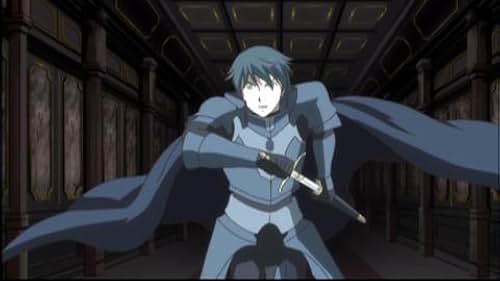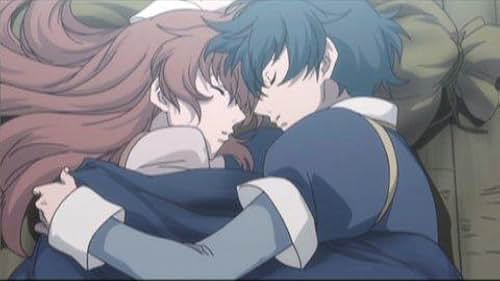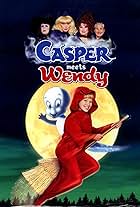Roughly based on Shakespeare's original, this fantastical tale is set in Neo Verona that houses the Capulet's and their rival's, the Montague's. Amidst the rivalry, Romeo and Juliet fall in ... Read allRoughly based on Shakespeare's original, this fantastical tale is set in Neo Verona that houses the Capulet's and their rival's, the Montague's. Amidst the rivalry, Romeo and Juliet fall in love.Roughly based on Shakespeare's original, this fantastical tale is set in Neo Verona that houses the Capulet's and their rival's, the Montague's. Amidst the rivalry, Romeo and Juliet fall in love.
Browse episodes
Photos
Storyline
Did you know
- TriviaThe playwright character, William, is most likely named for William Shakespeare, who penned the play "Romeo and Juliet," upon which this anime is loosely based. He also often quotes lines from Shakespeare's plays, and his own plays share the names and plots of Shakespeare's as well.
- GoofsThe credits show the first name of Shakespeare misspelled as "Whillian".
- ConnectionsFeatured in JesuOtaku Anime Reviews: Romeo x Juliet (2010)
Featured review
"Romeo x Juliet" is a 24-episode Japanese animated series with enough swashbuckling and fantasy touches to provide a significant departure from the ill-fated romance of Shakespeare's original text. For instance, in the first five episodes, Juliet is secretly the Red Whirlwind, a masked swordfighter (in male garb and a short-haired wig) who takes on the Carabinieri (government soldiers in chain mail) whenever they harass the citizenry. Romeo rides around on a winged horse called a "dragonhorse." Verona is now Neo-Verona, a city on a floating land mass (called an "aerial continent" in the opening) high up in the sky. There are occasional bits from the play that survive this adaptation, but not many. I watched the first half of the series (episodes 1-12) for this review.
Romeo is the son of the usurper, Prince Montague, who overthrew the House of Capulet 14 years before this takes place (seen in a flashback) and killed as many Capulets and their retainers as his men could find. Juliet is the sole surviving Capulet heir and has been raised as a boy, but is being groomed to lead an uprising against Montague from the moment she turns 16 and reveals herself to all as a girl, which happens in the second episode. The only problem, of course, is that Romeo and Juliet meet and fall in love. Each is torn between their duty and their love, but not enough to prevent their eventual staging of a symbolic wedding in an abandoned church. The romance plays out in the manner of so many anime series (think "His and Her Circumstances," to name one) as these two impossibly cute and innocent kids get over their awkwardness and start to feel comfortable with each other. One of the great things about anime series is the frequent practice of putting the plot on hold and allowing the characters to develop their relationships. At one point here, the two young lovers have a lingering romantic idyll on a long journey in the wilderness many miles from Neo-Verona. They even set up housekeeping for a spell in an abandoned farmhouse. These are truly lovely sequences that take up nearly two complete episodes.
Underlying it all is an ecological subtext that takes its cues from Hayao Miyazaki's LAPUTA: CASTLE IN THE SKY (1986), in which an abandoned orbiting structure is powered by a giant, mystical, gravity-defying tree that thwarts all attempts to harness its power. Here, there are two trees that power the floating continent on which Neo-Verona is situated. The trees are suffering, however, and we only gradually learn the extent of the trouble and its cause. Can this awful condition be cured? Stay tuned.
Many of the supporting characters have names from other Shakespeare plays: Portia, Benvolio, Cordelia, Titus, etc. Juliet grows up in hiding in a building that includes a theater and a resident playwright called "Willy," who resembles you-know-who. He's trying to come up with a new play and is drawn to Juliet's budding affair with the son of an enemy, but insists on waiting to see how it turns out before committing feather to parchment.
The DVD I watched offered both English and Japanese soundtracks. The signs on display in the city streets are all in Italian. The opening theme song, "You Raise Me Up," by Brendan Graham and Rolf Lovland, was a big hit for Josh Groban in 2004. Here it's sung with Japanese lyrics by Korean-American singer Lena Park. Ms. Park sings the English-language version of it in episode #7 to underscore a festival scene where Romeo and Juliet embrace and kiss at night against a backdrop of fireworks.
The whole thing is very nicely presented, with beautiful background designs drawing on Italian renaissance styles for the lavish palace interiors and more standard functional styles for the poorer, working class districts of the city. It's all done digitally, though, and I miss the bright colors and bold graphics we used to get from real colored ink and cell animation. Think "Rose of Versailles" (1979). This is an adequate substitute, I guess, but the clean consistency of the designs and backgrounds and the reliance on muted, often nearly washed-out digital coloring eliminates the splashes of breathtaking beauty and unpredictability we used to get in classic anime.
Romeo is the son of the usurper, Prince Montague, who overthrew the House of Capulet 14 years before this takes place (seen in a flashback) and killed as many Capulets and their retainers as his men could find. Juliet is the sole surviving Capulet heir and has been raised as a boy, but is being groomed to lead an uprising against Montague from the moment she turns 16 and reveals herself to all as a girl, which happens in the second episode. The only problem, of course, is that Romeo and Juliet meet and fall in love. Each is torn between their duty and their love, but not enough to prevent their eventual staging of a symbolic wedding in an abandoned church. The romance plays out in the manner of so many anime series (think "His and Her Circumstances," to name one) as these two impossibly cute and innocent kids get over their awkwardness and start to feel comfortable with each other. One of the great things about anime series is the frequent practice of putting the plot on hold and allowing the characters to develop their relationships. At one point here, the two young lovers have a lingering romantic idyll on a long journey in the wilderness many miles from Neo-Verona. They even set up housekeeping for a spell in an abandoned farmhouse. These are truly lovely sequences that take up nearly two complete episodes.
Underlying it all is an ecological subtext that takes its cues from Hayao Miyazaki's LAPUTA: CASTLE IN THE SKY (1986), in which an abandoned orbiting structure is powered by a giant, mystical, gravity-defying tree that thwarts all attempts to harness its power. Here, there are two trees that power the floating continent on which Neo-Verona is situated. The trees are suffering, however, and we only gradually learn the extent of the trouble and its cause. Can this awful condition be cured? Stay tuned.
Many of the supporting characters have names from other Shakespeare plays: Portia, Benvolio, Cordelia, Titus, etc. Juliet grows up in hiding in a building that includes a theater and a resident playwright called "Willy," who resembles you-know-who. He's trying to come up with a new play and is drawn to Juliet's budding affair with the son of an enemy, but insists on waiting to see how it turns out before committing feather to parchment.
The DVD I watched offered both English and Japanese soundtracks. The signs on display in the city streets are all in Italian. The opening theme song, "You Raise Me Up," by Brendan Graham and Rolf Lovland, was a big hit for Josh Groban in 2004. Here it's sung with Japanese lyrics by Korean-American singer Lena Park. Ms. Park sings the English-language version of it in episode #7 to underscore a festival scene where Romeo and Juliet embrace and kiss at night against a backdrop of fireworks.
The whole thing is very nicely presented, with beautiful background designs drawing on Italian renaissance styles for the lavish palace interiors and more standard functional styles for the poorer, working class districts of the city. It's all done digitally, though, and I miss the bright colors and bold graphics we used to get from real colored ink and cell animation. Think "Rose of Versailles" (1979). This is an adequate substitute, I guess, but the clean consistency of the designs and backgrounds and the reliance on muted, often nearly washed-out digital coloring eliminates the splashes of breathtaking beauty and unpredictability we used to get in classic anime.
- BrianDanaCamp
- May 17, 2011
- Permalink
Details
- Color
Contribute to this page
Suggest an edit or add missing content




















